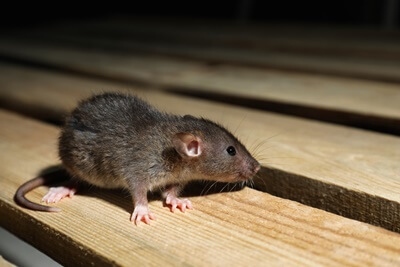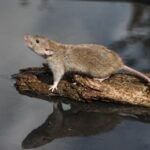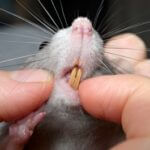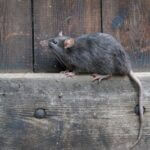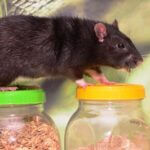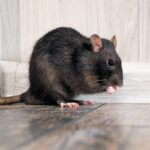Does one rat mean more rats? Surely, you can trap that single rat and be done with it. However, seeing one rat, especially during the day, means that more than one rat is likely hiding in your home.
It’s normal to find 5-10 rats in a nest, and there can be multiple rat nests in a colony.
Even if just one rat enters your home, it won’t be long before it finds a mate and reproduces. The same factors (food, water, warmth, and safety) that attract a single rat will also entice other rats.
How many rats are in your house? The worse the damage to your home and the more squeaking, screaming, and scurrying sounds you hear at night, the more rats you live with you.
If You Have One Rat, Do You Have More?
It’s unlikely you’ll have just one rat living in your home. One male and one female rat start packs before growing in number. Unfortunately, rats breed quickly.
It only takes 21-23 days for a female rat to gestate and produce a litter, and this can turn 2 rats into 5-10 rats in less than 30 days. As the babies grow, the parents create a nest for themselves and their offspring.
Once their offspring reach maturity, they’ll also reproduce. Once a large population is established, the nest will lead to many other nests, forming large colonies of up to 100 rats.
You may not be dealing with one family of rats. The same attractants that appealed to a mating pair may have drawn several mating pairs.
Independent rats looking for others to mate with can be drawn by the presence of other rats due to the breeding pheromones they produce.
Check for the following signs that you have more than one rat:
Number of Droppings
Look for small, black, sausage-shaped droppings about 1-2 cm long. The more droppings you find in your home, the more rats you have. A single rat can produce up to 40 droppings per night.
One rat will leave behind feces, but this will be a small amount and hard to find. If you locate poop in a fixed location or along a particular trail, you may have a rats’ nest.
If there are multiple nests and poop scattered everywhere, you have a colony. When you find rat poop throughout your home and in large amounts, you may have a diverse infestation.
However, check that you have rats and not mice.
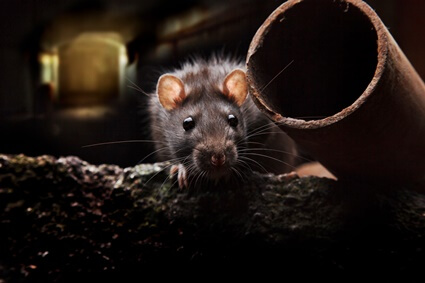
Bite Marks and Holes
In addition to seeking food, rats need to wear down their ever-growing teeth, which they do by chewing on abrasive items. So, always check for gnawing marks on wires and cabling.
You may find small holes in walls and floorboards, as rats’ teeth are coated in a tough enamel (iron gives them a yellow appearance). Rats can gnaw through wood and any substance softer than their teeth.
Nests
Rats shred soft materials like paper and fabric to create nests. If you find these materials together in a secluded place, you likely have many rats in your home.
Damage
Rats are relentless gnawers that chew on hard materials to file their teeth and prevent overgrowth. Their persistent chewing often damages electrical wires, insulation, water pipes, and plumbing.
You probably have many rats in your home if you notice inexplicable damage in these areas. Just a couple of shallow bite marks indicate one or two rats.
Noises
Rats are most active at night, so you’ll hear them moving around and making noises.
Listen out for squeaking, scratching, screaming, and scurrying back and forth. If the noise is faint, it could just be one rat. A rat infestation is likely if the noise is consistent and can be heard in various locations.
Odor
You’ll start to notice a musky smell in your home due to rat poop and urine. You’ll likely have dead rats if you’ve had a rat infestation for a while, and bodily decomposition will create a foul stench.
Sightings
Rats are most active from dusk to dawn. They spend the night foraging for food, and as dawn approaches, they return to their nests and spend the day sleeping.
If your rat is willing to forgo this security, there may be food competition or a lack of space. Overcrowding or needing to forage during daytime hours can force a rat out of its nest.
Is There Ever Just One Rat?
There are times when only one rat is living in your home. Occasionally, a single rat will wander off from its pack, get driven away, or leave to start a pack.
This won’t last for long, though. According to eLife Sciences, wild rats are social with other rats and prefer to live in groups. When that single rat can locate a mate, it’ll breed and multiply.
Depending on food and space availability, colonies may grow to 100 individual rats. Rats also reproduce quickly if their environment has sufficient food and water.
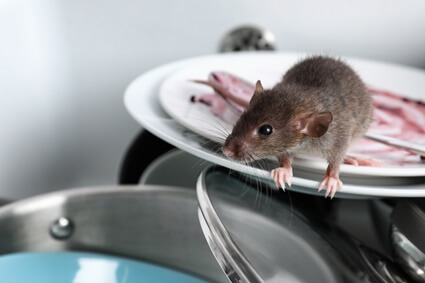
How Many Rats Live Together?
Rats are social creatures that live in packs consisting of related family members. A single nest will have 5-10 rats living together.
As the population grows, rats establish many nests close together to form colonies with hundreds of members. Rats build nests in attics, walls, and under the eaves of roofs.
Does Seeing One Rat Mean an Infestation?
Usually, finding a single rat means you have more than one rat. Finding a single rat that has strayed away from its pack is possible, but this is uncommon.
According to eLife, dominant rats evict weaker rats from the colony, which prevents the evictee from feeding or mating with females in the colony.
If you see rats during the day, the probability of an infestation is elevated.
Rats are intelligent creatures that can hide in their nests and remain unnoticed during the day. If they’re out and about, they’re likely overcrowded and forced to look for shelter and food when it’s light.
How Can You Tell If You Only Have One Rat?
The only way to tell if you have just one rat in your house is to catch it. If the noise stops and you don’t see any droppings, nests, or rats after catching one, you may not have more rats.
However, remember that rats are skilled at hiding without being detected. Catching a single rat and finding no more rats could mean the others are better at staying out of sight.
Rats won’t leave on their own, and it’s hard to starve rats out. They’re opportunistic animals that will stay in a nest if food and water are available.

